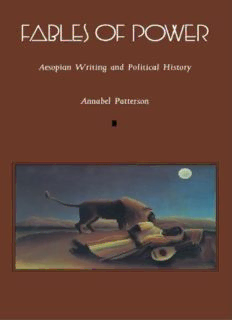
Fables of Power: Aesopian Writing and Political History PDF
Preview Fables of Power: Aesopian Writing and Political History
Fables of Power ■ Post-Contemporary Interventions Series editors: Stanley Fish and Fredric Jameson Fables of Power AESOPIAN WRITING AND POLITICAL HISTORY ■ Annabel Patterson Duke University Press Durham & London 1991 © 1991 Duke University Press All rights reserved Printed in the United States of America on acid-free paper ∞ Library of Congress Cataloging-in-Publication Data appear on the last page of this book. CONTENTS Acknowledgments Introduction 1 Aesop’s Life: Fathering the Fable 2 Fables of Power: The Sixteenth Century 3 “The Fable Is Inverted”: 1628–1700 4 Body Fables 5 “The World Is Chang’d”: 1700–2000 Postscript Notes ■ Acknowledgments Gratitude points first to the Rockefeller Foundation, at whose Study Center in Bellagio I was a guest when this book was assembled, in idyllic circumstances. It was also facilitated by a semester’s sabbatical leave from Duke University. Individuals who have contributed to it include Arthur Kinney, Gary Waller, and Gail Paster, each of whom made valuable suggestions and helped me to place my cards more squarely on the table; Dr. Josef Jařab, Barbara Herrnstein Smith, and Charles Williams, who supplied references I might not have found; Terri Clerico and Phillip Wegner, for valuable practical assistance; and Kevin Sharpe and Steven Zwicker, who not only permitted me to reprint from The Politics of Discourse my first essay on the politics of the fable, but provided the incentive to write it. Finally, I am grateful to my children, for being children no longer, and to my husband, Lee Patterson, whose Bellagio fellowship I was lucky to share as his spouse. Our manuscripts grew side by side on identical laptops and were finished together in congenial collaboration. ■ Introduction It was prettily devised of Aesop; “The fly sat upon the axle-tree of the chariot wheel, and said, ‘What a dust do I raise?’” —Bacon: “Of Vain-Glory” Quoting Sir Francis Bacon quoting “Aesop” quoting a fly,1 I admit that this project, though not actually making much of little, may be thought to do so. Whenever during its development its subject has been mentioned in casual conversation, it has met with some incredulity. Everybody has been, since childhood, familiar with Aesop’s fables, and almost everyone, consequently, believes them to be children’s literature. As Marcel Gutwirth put it, “pedagogical practice did more than its bit in creating an indissoluble bond between our notion of childhood and our notion of fable,” the latter now commonly thought of as “a place where the archaic and the puerile meet.”2 In fact, the fable’s use in elementary pedagogy was only one branch of the educational practice initiated by the Renaissance humanists who recovered the great texts of classical antiquity and made them the staples of early modern philology and rhetoric. And long after the boys of the sixteenth century had been taught what they could learn from the fable as a form—grammar, the essentials of narrative fiction, the relation between moral and exemplar—they were reading and rewriting fables for their adult sagacity and cogent, real-world applicability. This book describes the Aesopian fable as a hitherto underestimated function in Renaissance culture and subsequently. Partly thanks to their traditions of origin—how fables came to be written, by whom, and why—traditions which (whether or not they believed them) were deeply interesting to sixteenth-and seventeenth-century readers, the stories of the beasts, the birds, the trees, and the insects quickly acquired or recovered their function as a medium of political analysis and communication, especially in the form of a communication from or on behalf of the politically powerless. As Lydgate had put it for the late middle ages:
Description: